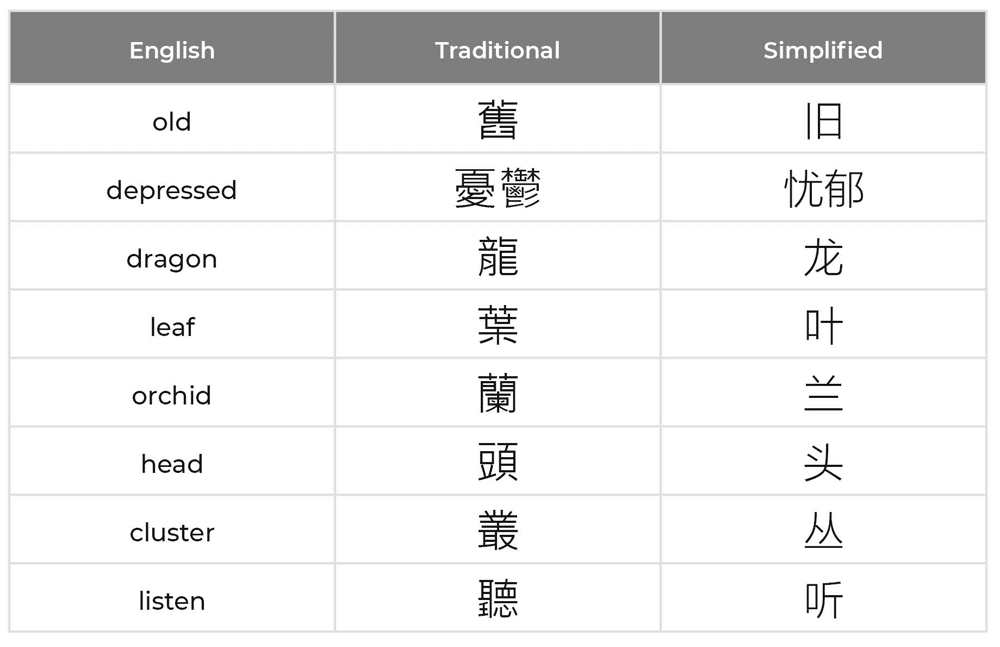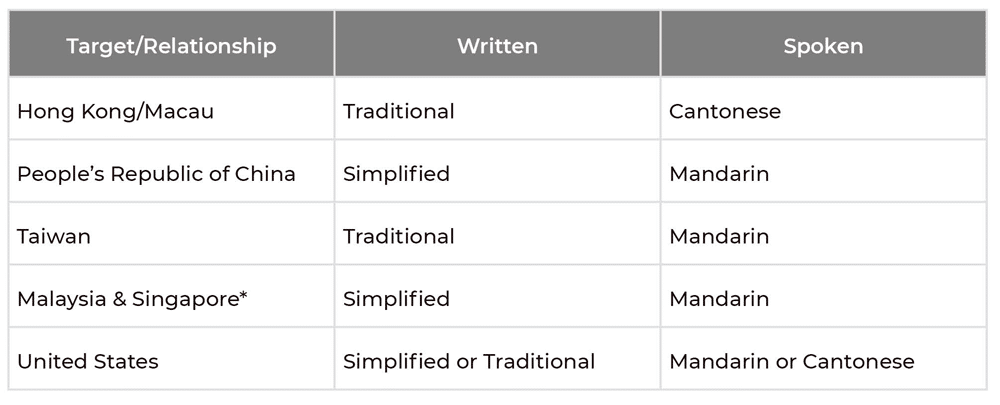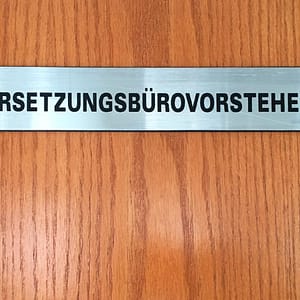Simplified vs. Traditional Chinese—What’s the Difference?
With 1.3 billion native speakers, Chinese holds the title of the world’s most widely spoken language. One quarter of the global population speaks some form of Chinese, and this includes 800 million active internet users—making the language hugely relevant to any organization that communicates globally.
Because Chinese is such an intricate and complex language, translation can be confusing to the uninitiated. A question we often hear is: “What’s the difference between Simplified and Traditional Chinese?” In this article, we examine the various forms of the language, so you can plan an informed translation strategy.
The Written Language — Simplified and Traditional Chinese
While the Latin alphabet has a core of 26 letters that can form an entire vocabulary, Chinese consists of tens of thousands of characters (or logograms) that are used to write single- and multiple-character words. Today, there are two different written forms of Chinese: Traditional and Simplified. Traditional Chinese preserves the orthodox characters that have been used for thousands of years. As its name suggests, Simplified Chinese consists of simplified versions of the traditional Chinese characters.
When the People’s Republic of China was established in 1949, the literacy rate in China was around 20%. Believing the steep learning curve of Traditional Chinese characters to be a factor, the government launched a campaign to promote literacy and education by simplifying the writing system. Approximately 2,000 traditional characters were modified, primarily by reducing the number of strokes and/or merging the characters. Throughout the 50’s and 60’s, Simplified Chinese was adopted in mainland China, Malaysia, and Singapore, while the people of Hong Kong, Taiwan, and Macau continue to use the Traditional writing system.
Key Differences Between Simplified and Traditional
Character Structure
Simplified Chinese characters have fewer strokes than their traditional counterparts, and therefore have simpler, less ornate structures.
Number of Characters
When Simplified Chinese was developed, some Traditional characters were merged, so the new language has fewer commonly used characters. While Traditional uses a single character to express a word or part of a word, Simplified may represent multiple words or concepts using the same character.
For example, the character 发 in Simplified Chinese equates to either 髮 (hair) or 發 (become/develop) in Traditional Chinese. When writing the phrase 头发发白 (hair turns gray) in Simplified Chinese, the two characters in the middle are identical, but have different meanings. Traditional Chinese represents each word in this phrase with a unique character: 頭髮發白 .
Vocabulary and Sentence Structure
Simplified and Traditional Chinese have some differences in word choice, vocabulary usage, and character sequences.
Here are just a few examples that illustrate how the same word can be represented by completely different characters:
- default: 默认 (Simplified), 預設 (Traditional)
- video: 视频 (Simplified), 影片(Traditional)
- speech: 讲话 (Simplified), 演說 (Traditional). In this example, when the Simplified Chinese usage is put into Traditional Chinese (講話), it means only “to speak,” as a verb, but not “speech,” as a noun.
These examples show the same word, written with the same two characters, but with the sequence reversed:
- Authentic: 地道 (Simplified), 道地 (Traditional)
- Late night supper: 夜宵 (Simplified), 宵夜 (Traditional)
Next, we have an example of two characters that have very different meanings:
- 土豆 means potato(es) in Simplified Chinese, but in Traditional, it means peanut(s).
Punctuation
Simplified and Traditional have some punctuation differences. As an example, Simplified Chinese uses Western-style quotation marks “…” and ‘…’. When embedding quotes, the single marks are placed inside the double marks like this: “…‘…’…”. However, in Traditional Chinese, single quotation marks are rendered as「…」 and double as『…』. When embedded, Traditional takes the opposite treatment,「…『…』…」placing the double quotations within the single marks.
Text Flow
The majority of Simplified text only flows horizontally, and readers in China are used to a horizontal layout. Traditional Chinese, however, can be written either horizontally or vertically, and can even flow both ways on a single page.
Chinese Translation—Simplified or Traditional?
Simplified Chinese is typically used when translating for mainland China, Singapore, Malaysia, and international organizations such as the United Nations and the World Bank. However, when translating for audiences in Hong Kong, Taiwan, Macau and international immigrant communities, Traditional Chinese is the norm.
The forms of Traditional Chinese used in Taiwan and Hong Kong have evolved over time, and each country has developed some of its own unique terms. While the forms of writing are mutually intelligible, Taiwanese text will not read as naturally to people from Hong Kong, and vice versa. In translation, it is always best to select the form of a language that sounds most natural to the reader. Therefore, when translating specifically for Hong Kong, it is best to select Traditional Chinese for Hong Kong, while text for Taiwan is ideally translated into Traditional Chinese for Taiwan.

Simplified vs. Traditional Chinese
Download this PDF to learn more about where Simplified and Traditional Chinese are spoken, and better understand the languages' characters and punctuation.
Download Now"*" indicates required fields
Translating for U.S. Audiences—Simplified or Traditional?
The Chinese represent the third largest immigrant group in the U.S., following Mexicans and Indians, with approximately half of all Chinese immigrants living in either California (32%) or New York (19%).1 Both cities include communities established before the advent of Simplified Chinese, and many residents still use Traditional characters. However, more recent influxes of Chinese immigrants have significantly diversified the Chinese populations across the country. The only way to make sure that your message is understood by all U.S. Chinese speakers is to translate into both Traditional and Simplified Chinese.
Get in Touch!
Reach out to discuss your next translation project with a member of our team.
The Spoken Language—Mandarin or Cantonese?
Due to China’s immense geographical and cultural diversity, the country boasts an assortment of spoken languages and dialects, many of which are mutually unintelligible. The most common are Mandarin and Cantonese, which are spoken throughout the world.
Cantonese is believed to have originated after the fall of the Han Dynasty in 220 A.D., while Mandarin arose out of the Yuan Dynasty in the 14th century. In 1912, China named Mandarin as its official language, and today Standard Mandarin remains the country’s lingua franca. Mandarin has become the only dialect that is common among Chinese throughout the world.
While Cantonese originated in the Guangzhou region of Southeast China, and is still spoken in the area today, the language has spread far and wide. Cantonese is spoken by significant immigrant communities around the world, including New York and California. Due to immigration trends, as well as social and political factors, language usage continues to shift. While Cantonese (and English) are official languages of Hong Kong, Mandarin usage is rising. When the UK returned Hong Kong to China in 1997, one quarter of the population spoke Mandarin. Today, that number has almost doubled.
* Singapore is linguistically diverse, with four official languages: Malay, Chinese (Simplified/Mandarin), Tamil, and English. Due to the country’s bilingual education policy, many citizens are able to speak two or more languages.
Featured Services
Learn more about…
We’re Here to Help
Translation into Chinese can open doors around the world. But as with any language, it’s important that the language sounds natural. Work closely with your translation provider to select the correct written and/or spoken Chinese for your audiences.
 Named to the 2024 Inc. 5000 list of fastest-growing companies and ranked among the world’s top 100 language service providers by CSA Research
Named to the 2024 Inc. 5000 list of fastest-growing companies and ranked among the world’s top 100 language service providers by CSA Research



